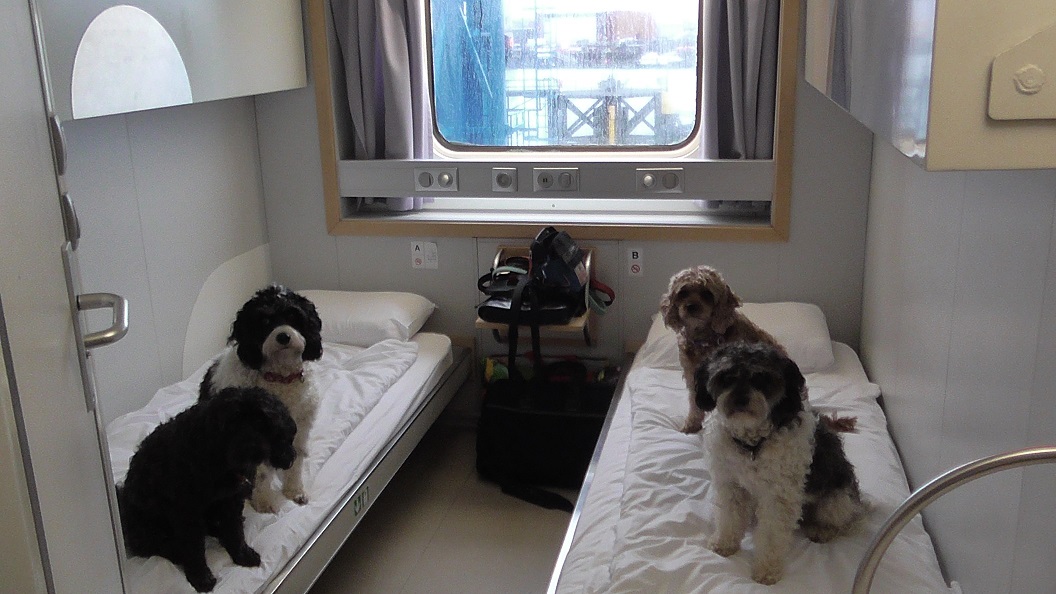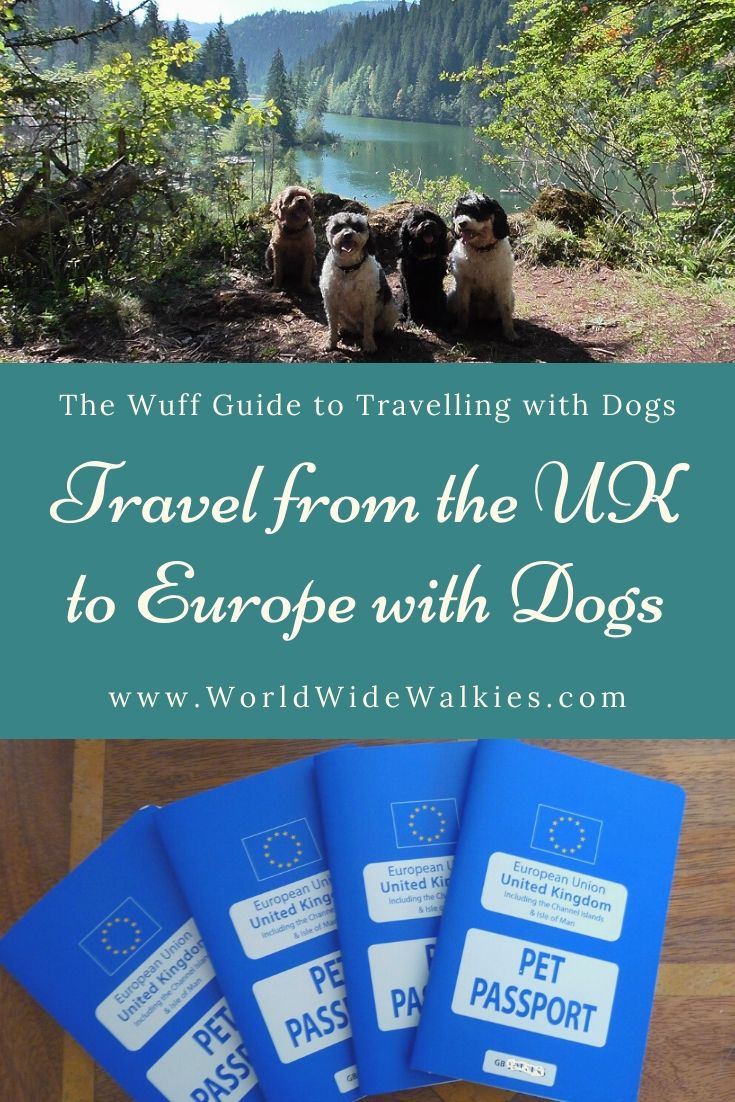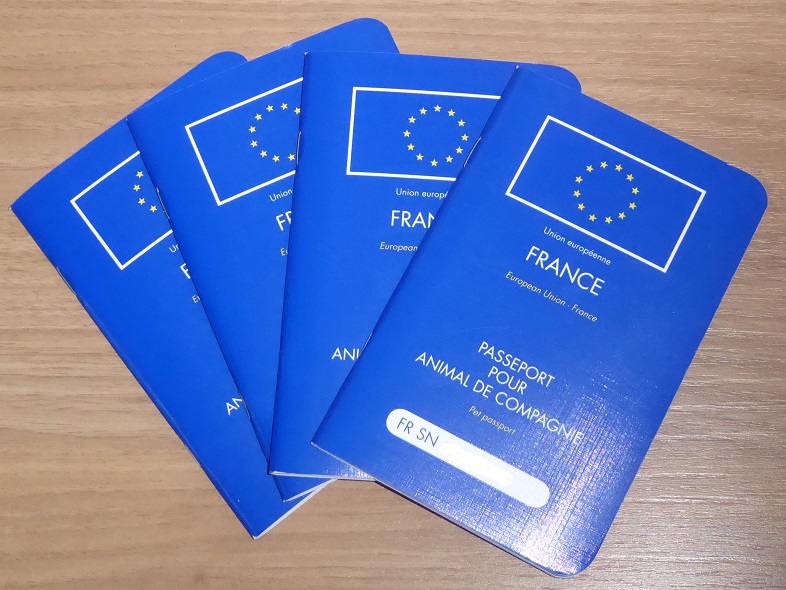Updated with new information January 2021, after the Brexit transition period ended.
Surrounded by sea in Splendid Isolation, Britain has understandably been very protective about keeping herself free from dangerous diseases, such as Rabies. Thankfully, the development of an effective Rabies vaccine saw the end of the 6 month quarantine for pets returning to the UK.
Since Britain left the EU on 1st January 2021, the ease of taking pets abroad has changed. To help, I have updated this guide, which highlights all you need to know about entry requirements, banned breeds – and the best and most comfortable ways for your pets to travel.
- Can I Take My Pet Abroad?
- Taking My Pet Abroad – What Do I Need?
- Bringing My Dog Into the UK – What Do I Need?
- Finding a Vet Abroad
- Approved Routes
- Pets Are Regarded as Cargo – So What’s the Best Way to Travel?
- What if the Worst Happens?
- Links
- Useful? Please Share on Pinterest!
1. Can I Take My Pet Abroad?
This is the first question that you should ask yourself before you travel.
A. Banned Breeds
This might apply if you own a bulldog-type, attack dog or fighting breed, such as a Staffie, Pit Bull, Mastiff, Japanese Tosa, Doberman or Rottweiler. You should be aware that some countries, states and even some cities may have ‘breed-specific legislation’ which bans certain dog breeds. These are breeds which are perceived as more dangerous than others.
The restrictions vary according to the country; in France pedigree papers may enable entry for certain banned breeds; in Spain dangerous dogs must be registered, insured and licenced; in the laid-back Netherlands all dogs are permitted – unless they show aggressive behaviour. Croatia, however, will not even permit a banned breed to transit the country en route to its final destination.
Please double check with an official website or embassy for the countries that you intend to transit or visit. Failure comply could mean that you are denied entry or worse, that your dog is impounded or destroyed.
Legislation may require banned breeds to be muzzled in public and there are heavy penalties for non-compliance.
So do your homework!
B. Can I Travel Straight Away? – NO!
- Rabies Vaccine – allow at least one month before travel.
- Your dog must be more than 12 weeks old to receive the Rabies Vaccine.
- The Rabies Vaccine is not effective for 21 days, so allow a month before travel.
- Animal Health Certificate – 10 days before travel
- Any pet travelling to the EU or Northern Ireland (NI) from England, Wales and Scotland after 23:00 GMT on 31st December 2020,will need an ‘Animal Health Certificate’ (AHC) issued by an Official Vet. Click here for my blog about Animal Health Certificates – What You Need To Know.
- Rabies Blood Titer Test – allow at least four months before travel.
- The Titer Test verifies that the Rabies jab has worked by checking for an effective level of rabies antibodies in the blood.
- It is required for pets coming to the UK (and other European countries) from any unlisted country.
- Some countries such as Serbia require a titer test regardless of your country of origin.
- Verification of the titer test takes about four months (plus additional time if your pup fails the test and requires a re-test) and must be performed by an approved laboratory.
- For most countries, a titer test remains valid so long as rabies boosters are kept up to date. Note that some countries do not recognise a 3 year rabies jab and require annual boosters, and some countries do require a titer test to have been carried out within one year prior to entry.
WWW Tip – Check that your pet’s rabies vaccination does not expire during your trip, or you won’t be able to re-enter the UK.
WWW Tip –If you intend to travel outside the EU to unlisted countries, eg to many Schengen Shuffle countries, such as the Balkans, Morocco, or Turkey, you will need a rabies blood titer test to get home – so get it done in the UK or EU before you travel.
Vaccination is not just a formality; rabies is incurable and 100% fatal in both humans and dogs. So best not to travel before the vaccination has become effective or after it has expired!
C. Travelling with More than 5 Pets
We travel with four dogs with no problem. If you travel with more than 5 dogs, the rules become more strict. Click here for full details on the UK Government website.

2. Taking My Pet Abroad – What Do I Need?
- Animal Health Certificate (AHC) or EU Pet Passport
- The AHC replaces the GB issued EU Pet Passport. For more details on the what, wheres and hows of AHCs, see Animal Health Certificates – What You Need To Know.
- EU passports are still acceped for entry into GB and onward travel around the EU. Our four travel on French passports. If you want to try to get an EU pet passport, see Can I Get My Dog an EU Pet Passport?
- Travel with Original Documents – Photocopies are not acceptable.
- Extra Entry Requirements in Some Countries – make sure that you are aware of the full entry requirements for each country that you will be visiting before you travel. These are a few things to look out for:
- Tapeworm (Echinococcus) Treatment – Finland, Ireland, Malta, Northern Ireland, Norway and the UK require tapeworm treatment to be administered between 120 hours (5 days) and NO LESS than 24 hours prior to entry (detailed in section 2. C. below).
- 3-Year Rabies Vaccination Not Accepted – some countries, eg Ukraine do not accept the 3-year rabies vaccination, so you can only travel to these countries between 30 days and 12 months after your dog’s rabies vaccination.
- Rabies Titer Test Required as WELL as Vaccination – some countries, eg Serbia require a rabies titer test regardless of whether your dog is vaccinated. Note the requirement for a rabies titer test to re enter the UK and EU if you have visited an unlisted country.
- Quarantine – we discovered that to take four dogs into Russia, they would have to go into quarantine, however fewer than four dogs do not.
- Pet Food – you will NOT be permitted to take pet food into the EU unless for medical reasons. See the section on Taking Food and Drink Into EU Countries.
Check for full and current details for entering the UK on the UK Government Website.
Pet Travel.com is an excellent website which shows entry requirements for over 200 countries as a guide. I cannot vouch for the complete accuracy of all information, since I have found at least one anomaly; (according to the UK Gov website only, Romania is not low risk but a ‘high risk’ country for rabies), however it is good to have all the information in one place to highlight any potential special entry requirements of the country that you wish to visit so that you can check into it more thoroughly.
3. Bringing My Dog Into the UK – What Do I Need?
Rabies Titer Test – if you have travelled outside the EU to any unlisted country. (this includes many of the Schengen Shuffle countries), you will need a titer test to re enter the EU and UK.
Tapeworm (Echinococcus) Treatment (dogs only) – Between 120 hours (5 days) and NO LESS than 24 hours before entering or re-entering the UK (and the other countries listed above) your dog must be examined by a vet and treated against tapeworm, usually by administering a single pill.
The treatment must be recorded in the AHC or pet passport. The method of recording MUST BE CORRECT – or you will not be able to travel!!!!
Check that the vet has put the following details in the ‘Anti-Echinococcus Treatment’ section of your dog’s Pet Passport:
- The name and manufacturer of the product with which your dog was treated
- The date and time they treated your dog, recorded in 24-hour clock format
- Their stamp and signature

In ports, vets are fairly au-fait with the procedure, but ‘in the sticks’ where the passport procedure is less familiar, we have found that you will have to make sure that the information is recorded correctly.
For example, a vet in the Italian Alps wrote the date and time that we were scheduled to travel in the passport, rather than the date and time of treatment. Had we not known the procedure and asked her to correct it, we would have been unable to travel. On the up side, she was lovely and didn’t charge us a cent, while the vet in France got it right but was rude and charged us over €100!
You might find the Facebook group RECOMMENDED VETS FOR TAPEWORM TREATMENT helpful in locating an English-speaking vet who won’t overcharge.
WWW Top Tip – Get the tapeworm pills from your own vet and take them with you. We found this to be much less expensive. You are also certain which treatment is being given to your dog.
Our little Ruby became very ill indeed after one trip, possibly in response to Prazical administered by a French vet. Within 24 hours of the treatment, she developed terrible diarrhoea, refused to eat and lost 30% of her body weight. The curative vet treatment cost over £300. We can never be certain that it was the tapeworm treatment that caused the illness, but we really thought that we were going to lose her and are certainly not prepared to risk it again. Sticking with Milprazon on the advice of our own vet, we have had no problems since.

4. Finding a Vet Abroad
Brittany Ferries lists vets near the ports from which they operate. To comply with pet import regulations, you would need to be in the port more than 24 hours before departure to get the tapeworm treatment. (As stated above, the tapeworm treatment must be administered no less than 24 hours prior to travel.)
You might find the Facebook group RECOMMENDED VETS FOR TAPEWORM TREATMENT helpful in locating an English-speaking vet who won’t overcharge.
We tend to just look up a local vet on the internet (there are usually plenty of reviews to help you choose.) For a map showing vets in Europe who are familiar with The Pet Passport Scheme, click here. The Searchforsites app also lists vets with reviews; click on ‘filter’, scroll down to ‘other’ and ensure you’ve ticked the’European vet’ box. Alternatively, ask at campsite reception. They will frequently recommend a vet and even book the appointment for you.
5. Approved Routes

It is possible to bring pets into the UK only via ‘approved routes’. Good to be aware, but nothing to worry about if you are travelling on the Eurotunnel or Ferries. Click here for full details.
6. Pets Are Regarded as Cargo – So What’s the Best Way to Travel?
A. Ferry

- Pet Friendly Cabins – a limited number are available on some crossings, so book early. The ferry companies often stipulate that these accept only a single pet, although Brittany Ferries was happy to discuss. Staying with The Fab Four in a pet-friendly cabin is our favoured option. Click here to see how we got on with The Fur Friendly Ferry to France and find details of which crossings offer this service.
- Kennels – On our first trip, we went to France by ferry from a port close to home. We booked The Fab Four into kennels on the ferry, thinking that this would be the most comfortable for them. It was THE MOST HORRIFIC THING WE HAVE EVER DONE TO OUR BABIES! For full details, see my blog Livin’ the Dream Week 3 – The Great Continental Divide
- In Your Vehicle – On the return ferry, we left the pups in the caravan. At least they were in familiar surroundings and could move around.
The Exercise Deck – With option 1, you have unlimited access to a small exercise deck to stretch and do the necessaries. With options 2 and 3, you are allowed an escorted visit to your pet every couple of hours to take him on to the exercise deck for about 10 minutes. Since it is a stressful situation and everyone is exercising together, you are supposed to use muzzles, but we have never seen this enforced. Clearly, a muzzle is advisable if your dog is nervous or uncomfortable with other canines.
Pick The Time of Your Crossing – After our first trip, I heard a terrible story about someone’s dog, who died from heat exhaustion on the cargo deck during a ferry crossing on a particularly hot day. As such, you are well advised to choose the timing of your crossing to avoid such hazards.
B. The Channel Tunnel

While it generally involves a longer drive for us at either end, the half-hour tunnel crossing with everyone in the car together is quick and you can all stay together in your vehicle.
However, we fell out with Eurotunnel Le Shuttle when a £2 admin charge went up by 4,500% overnight when we asked to bring forward our booking on the day of travel. We have not used them since. While Le Shuttle will often allow you to travel on an earlier train for no extra charge, we advise you to be aware that it could be costly to alter your booking on the day.
C. Check-in With Pets on the Ferry or Tunnel
This is straightforward, but do allow a little extra time.
Pet Check-in simply involves checking the Pet Passport and verification of the dog’s microchip with a hand-held reader. Technically, dogs are supposed to wear muzzles while this is carried out, but again, we have never had this enforced. You know your pet; just use your judgement.
- At the Channel Tunnel, there is a separate Pet Check in Area and even little doggie exercise parks! At peak times, there could be queues at Pet Check in, so allow for this.
- On the Ferry, in our experience with Brittany Ferries, check in is at the booth where you would normally check in yourself and your vehicle.
7. What if the Worst Happens?
We travel for long periods in Europe. “Plan for the worst; hope for the best!” is always good advice. Nobody likes to think of themselves shuffling off this mortal coil. Indeed, we hope to have a long and happy life ahead of us;
But what happens to the Fur Babies, stranded abroad, if anything happens to us?
- We have set out in our wills what should happen to our pups in the event of our deaths;
- We have made financial provision to cover the costs of care for their lifetimes.
- We have appointed a trusted friend to oversee finding them suitable homes together, along with a list of potential homes; the candidates are friends to whom we have spoken about giving our darlings loving, forever homes.
- If you don’t have a willing friend, the RSPCA offers a ‘Home for Life’ scheme.
- We have left details of our vet, a list of their favourite food brands and treats, the quantities we feed them, the commands that they respond to and how often they need to be groomed. You could consider including medication and any other information that might be useful to someone taking them on.
- Your trusted friend may also come into play with repatriation of pets in the event of your death. This can also be covered in your travel insurance.
8. Links
- The information is correct at the time of writing. For full and up to date information on the ‘PETS’ travel scheme, click here to link to the pet travel section of the UK Government website before you travel.
- Click here for the Eurotunnel website, which also has a very easy-to-understand guide to travelling to Europe with pets.
- You may also be interested in my related blogs about travelling with dogs, which you will find in The Wuff Guide to Travelling with Dogs
- Pet Travel.com lists the entry requirements for over 220 countries. Since requirements change frequently, do double check with the official website of the countries that you will be visiting.
Please feel free to share my blog with anyone thinking of travelling to Europe with dogs.
Further specific advice on travelling with dogs will be published as we progress around Europe with The Fab Four, including how to adopt and get a passport for a Romanian stray! If you ‘follow’ my blog, you won’t miss it.
For advice on bringing dogs to Europe from the US, check out this excellent article “Requirements for Getting Your Dog Into the EU from fellow blogger & canine travellers Gator and Nuthin.
Useful? Please Share on Pinterest!



Fascinating.
LikeLiked by 1 person
Unfortunately, it’s more complicated if you want to come to the UK from Oz with furry friends…
LikeLike
Really useful info! We’re thinking about taking our rescue dog to Belguim next year for his first trip abroad. I’m a little anxious about the rise of Brucella Canis in Europe.. I was wondering if it would affect your decisions going to Europe with your pooches?
LikeLiked by 1 person
Glad you found my post useful.
We’re already in Europe with the pooches. I’m not overly worried about Brucella Canis for a number of reasons.
1. I understand it is still relatively rare.
2. It is primarily a sexually transmitted disease, most often found in dogs imported from endemic countries, such as Eastern Europe, for rehoming, or bred with these dogs.
3. The bacterium does not survive for very long outside the host and is easily killed with disinfectants.
3. While it can be transmitted by direct contact with bodily fluids such as blood, saliva and urine, via the nose, mouth or eyes, the low survival rate outside a host suggests that such transmission would only really happen in crowded conditions, such as in kennels.
4. The most common route of transmission in dogs is fluids associated with pregnancy and birth, such as semen, milk, placenta or an aborted foetus.
5. All our pups are neutered or spayed. They do not have sexual contact with other dogs and do not spend time crowded together with other dogs.
Brucella Canis is a zoonotic disease, so it can transmit to humans, although that is rare. Again, it is most likely through contact with fluids associated with pregnancy and birth, and the greatest risks are for people who are immunocompromised. As far as I am aware, only one person has been infected in the UK, although the GOV website (updated in Feb 2021) still maintains that the number of dog to human transmissions in Britain is zero.
This map of distribution of B Canis in March 2021 suggests that the UK has more cases than most of Europe, although I have read that it is difficult to understand the distribution of the disease because it is frequently asymptomatic. https://pubmed.ncbi.nlm.nih.gov/33738302/#&gid=article-figures&pid=figure-1-uid-0
There is always a risk, of course. However, I tend to work my risk assessments based on likelihood versus severity. Canine Brucellosis is a nasty and usually incurable disease in dogs, however the likelihood of contracting it is low.
.
LikeLike